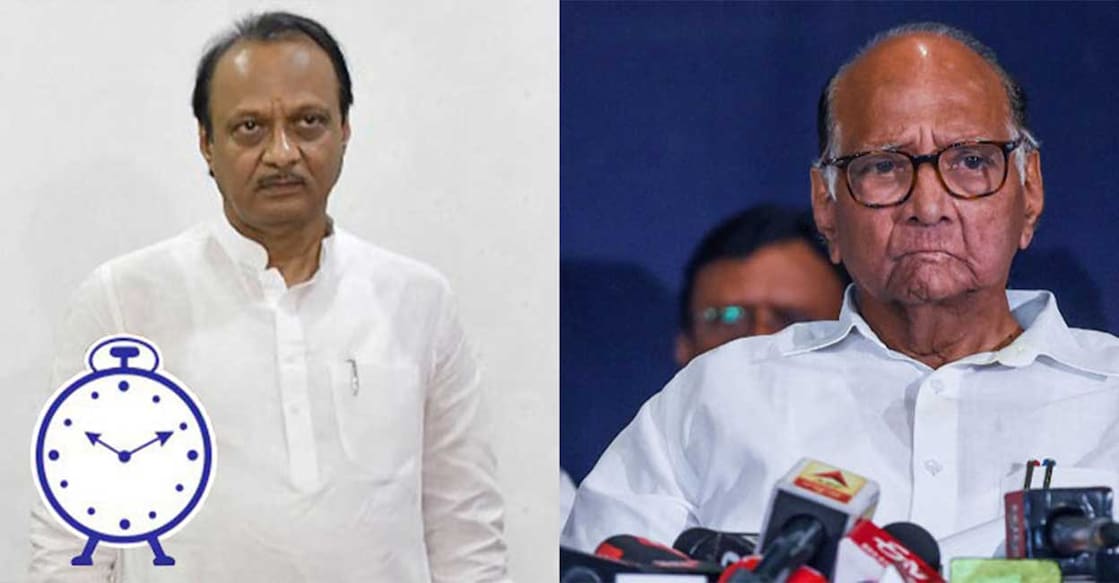Explained | How EC ruled in favour of Ajit Pawar in NCP dispute?

Mail This Article
The Ajit Pawar faction is the real Nationalist Congress Party (NCP), the Election Commission announced on February 6, in a major setback to party founder Sharad Pawar.
The EC also allotted the NCP symbol ‘clock’ to the group led by Ajit Pawar.
What is the dispute about?
• Sharad Pawar founded the Nationalist Congress Party (NCP) in 1999 after breaking from Congress.
• Ajit Pawar had walked away with a majority of NCP MLAs in July 2023 and supported the BJP-Shiv Sena government led by Chief Minister Eknath Shinde in Maharashtra.
• He was sworn in as deputy Chief Minister of Maharashtra.
• The move caused a split in the NCP, with one faction supporting Sharad Pawar and the other backing Ajit Pawar.
• Ajit Pawar submitted a petition to the EC two days before he and eight other MLAs took oath as ministers in the Shinde government.
• The total number of legislators, including MPs, MLAs and MLCs belonging to the NCP stands at 81.
• Election Commission said that 57 had filed affidavits declaring support for Ajit Pawar and 28 for Sharad Pawar. However, five MLAs and one Lok Sabha MP filed affidavits in support of both factions.
• EC said even if these were to be counted along with affidavits favouring Sharad Pawar, the Ajit Pawar faction would still have a numerical majority of 51 of 81 legislators.
• The poll panel announced that the Ajit Pawar faction is the real Nationalist Congress Party (NCP).
• The ruling ended months of speculation over the factional fight between Ajit Pawar and his uncle Sharad Pawar.
• The decision followed the laid-out tests of maintainability of such a petition which included tests of aims and objectives of party constitution, test of party constitution and tests of majority both organisational and legislative.
• The EC made a concession to the group led by Sharad Pawar by allowing it a one-time option to claim a name for its political outfit and provide three preferences in view of the upcoming Rajya Sabha elections.
How Election Commission decides on party symbol disputes?
• The EC is usually guided by Paragraph-15 of Symbols (Reservation and Allotment) Order, 1968 and the 1972 Supreme Court order in Sadiq Ali vs Election Commission.
• The Symbols Order has been issued by the Commission in exercise of the powers conferred by Article 324 of the Constitution read with Rule 5 and 10 of the Conduct of Election Rules.
Paragraph 15 deals with power of Commission in relation to splinter groups of rival sections of a recognised political party. It states that:
When the Commission is satisfied on information in its possession that there are rival sections or groups of a recognised political party each of whom claims to be that party, the Commission may, after taking into account all the available facts and circumstances of the case and hearing such representatives of the sections or groups and other persons as desire to be heard, decide that one such rival section or group or none of such rival sections or groups is that recognised political party and the decision of the Commission shall be binding on all such rival sections or groups.
Sadiq Ali and another vs Election Commission case
• In 1969, there was split within the Indian National Congress giving rise to two groups, one led by Indira Gandhi, under the presidentship of Jagjivan Ram and the other group led by S. Nijalingappa.
• After recording the evidence and hearing detailed submissions of both the groups, the Commission came to the conclusion that the group led by Jagjivan Ram enjoyed the majority support, both in the organisational and Legislature wings of the party, and, consequently, recognised that group as the Indian National Congress, by its order on January 11, 1971.
• The rival group led by Nijalingappa felt aggrieved by the Election Commission’s order and filed the present appeal before the Supreme Court.
• The Supreme Court held that the test of majority or numerical strength applied by the Commission for determining the dispute was a relevant and valuable test, and rightly applied by the Commission.
• The Supreme Court also held that paragraph 15 of the Symbols Order was not ultra vires the powers of the Election Commission under Article 324 of the Constitution. Further, the Court held that an election symbol is not property of the party concerned.
Three tests by Election Commission
The Election Commission considered and applied three tests as envisaged in the Sadiq Ali case.
1) Test of Aims and Objectives of the Party Constitution
• First, the Test of Aims and Objectives of the Party Constitution was considered. It was seen that neither of the rival factions had contended that their faction was following the aims and objectives of the party constitution and that the other side was violating it.
2) Test of Party Constitution
With respect to the Test of Party Constitution, it was seen that while both the rival factions had no dispute on the party constitution, they were not adhering to the same and thus, this test also failed to give any determinative result.
3) Test of Majority
The EC relied on the Test of Majority to decide the present dispute case, following the precedents of past many cases. The commission proceeded to determine the present dispute case on the basis of test of majority in the legislative wing. The EC examined the affidavits of support filed by both the factions and concluded that the group led by Ajit Pawar enjoyed majority support among the legislators.
The test of numbers was employed by EC last year to rule on the split in Shiv Sena.




